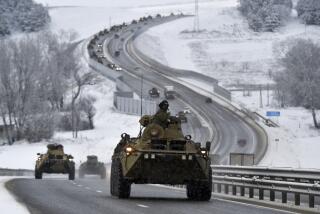OPEC Freezes 3rd-Quarter Production : Oil: The agreement will probably keep prices steady. Kuwait is exempt.
- Share via
VIENNA — OPEC patched together an accord Friday that would freeze third-quarter oil production at the group’s current ceiling but allow Kuwait to raise production as its war-damaged oil fields come back on line.
Industry analysts said the accord hammered out during two days of talks will probably keep oil prices steady for the next few months.
Ministers emerging from talks held by the Organization of Petroleum Exporting Countries said they had agreed to extend their second-quarter production ceiling of 23 million barrels per day into the third quarter of 1992.
Oil prices rose on the OPEC move. The production level was less than the 24 million barrels that traders had expected.
But Kuwaiti Oil Minister Hamoud Rogba told reporters that there would be no limits on the emirate’s output as it rebuilds its industry after the devastation of the Gulf War.
OPEC Secretary General Subroto said only Iraq had refused to sign the pact.
“Iraq rejected the agreement,” he told reporters. He said Baghdad had wanted the cartel’s final communique to include a provision that OPEC meet again as soon as the lifting of U.N. trade sanctions allows Iraq to resume exporting oil.
“I reject this agreement because it is dictated by Saudi Arabia--dictated in all its essences,” said Iraq’s oil minister, Usama Abdel-Razzak.
Morgan Stanley analyst Paul Mlotok said the deal will probably raise OPEC’s production limit to 23.5 million barrels a day in the third quarter. If members exceed their quotas, actual output is likely to approach 24 million, he said.
“The call on OPEC should be somewhat less than 24 (million), but it is normal to build inventories in the third quarter, so the situation seems as if on an unofficial basis it will work out to about the right solution,” Mlotok said.
“In the end, the world should get the oil that it needs. Whatever inventory build occurs is unlikely to be excessive, and hence the oil price is likely to stay fairly stable,” he said.
This would leave prices below OPEC’s target of at least $21 a barrel but above the prevailing prices in the first quarter and perhaps in the second quarter as well. OPEC’s reference basket of seven grades of crude oil averaged $18.48 a barrel last week.
Prices edged up a bit on futures markets after the deal was announced, with spot crude oil settling 4 cents higher on the New York Mercantile Exchange.
Delegates said Saudi Arabia, the world’s largest crude exporter with more than a third of OPEC’s output, had wanted to raise production in anticipation of improved demand in the fourth quarter of the year.
Iran, OPEC’s second-largest producer, argued vigorously against raising the output ceiling until prices got closer to the $21 target.
But the two powers compromised by agreeing to extend the current deal, adding the same formal reservations they expressed in February when OPEC set an official output ceiling of just under 23 million barrels.
In fact, output by the 13-member producers’ group averaged 23.3 million barrels a day in April.
The OPEC meeting, which officially opened Thursday, took several unusual turns.
Saudi Arabia’s influential oil minister, Hisham Nazer, stayed home at the last minute, pleading fatigue and sending a junior minister in his place.
Weeks before the meeting, the kingdom put out the word that it would press for a new output ceiling of 24 million barrels a day.
Such a high level was certain to be opposed by Iran’s feisty minister, Gholamreza Aqazadeh, who has often sparred with Nazer at recent meetings.
In the end, it appeared that Saudi Arabia had not pushed for the higher ceiling.
A Persian Gulf source, demanding anonymity, said it became clear that other OPEC delegations would not easily go along.
So, the others called for a “rollover” of their spring production ceiling of 22.98 million barrels a day.
More to Read
Inside the business of entertainment
The Wide Shot brings you news, analysis and insights on everything from streaming wars to production — and what it all means for the future.
You may occasionally receive promotional content from the Los Angeles Times.










